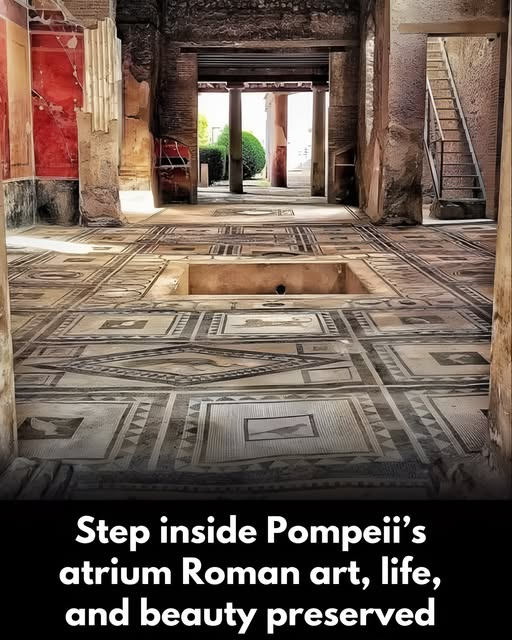
The atrium is silent now. The laughter, the conversations, the footsteps that once echoed on its intricate mosaic floor have long since faded. Yet, as you step into the preserved heart of this Roman house in Pompeii, you can almost hear the whispers of lives once lived, suspended in an eternal moment.
Imagine the year is 79 AD. The city of Pompeii thrives under the shadow of Mount Vesuvius, unaware of the catastrophe that will soon bury it beneath ash and pumice. In this very atrium, a Roman family begins its day. The atrium was the beating heart of the Roman home — a space where private life met public duty, where family rituals intertwined with the display of wealth and culture.
The mosaic floor beneath your feet is not just decoration. Each geometric pattern, each tessera of stone, was carefully chosen, painstakingly set by artisans who knew that floors spoke of idenтιтy. To the Romans, beauty was not a luxury — it was an expectation, an extension of order, discipline, and the divine.
At the center of the atrium lies the impluvium — the sunken basin designed to collect rainwater through the open roof above. This simple, practical feature reveals so much about Roman ingenuity. Water, the essence of life, was guided gracefully into the household, becoming both function and symbol. The reflections of the sky in that shallow pool must once have dazzled guests, a reminder that nature itself was invited into the architecture of the home.
Look up at the painted walls, where fragments of red and ochre still cling stubbornly to stone. These frescoes once told stories, myths of gods and heroes, or landscapes painted to extend the space beyond its physical limits. They weren’t merely ornamental; they were cultural anchors. Through them, the household declared its literacy in Rome’s shared imagination.
But behind the art and elegance lies the human story. This was not just a stage set — it was a lived-in space. Imagine the family gathering here in the morning light. A father discussing politics with a visitor. A mother overseeing the household. Children running across the mosaic floor, their sandals clattering. The atrium was alive with energy, with daily rituals, with the subtle pulse of Roman life.
Now, centuries later, archaeologists step into this very space, brushing away layers of volcanic ash. What they uncover is not just architecture but memory, fossilized in stone. Each discovery — a fragment of pottery, a piece of jewelry, even the preserved body of a dog curled in a corner — reminds us that this city was not an abstraction. It was a living, breathing community.
The tragedy of Pompeii is precisely what preserved it. The eruption of Mount Vesuvius froze the city in time, creating one of the most extraordinary archaeological archives in the world. Without that disaster, these mosaics might have faded away, replaced or destroyed by centuries of rebuilding. Instead, they stand as a window into the past, bridging millennia to bring us face to face with people who, in many ways, were just like us.
And it is here, standing in this atrium, that the emotional weight of Pompeii is felt most strongly. The grandeur of Rome is often measured in amphitheaters, temples, and imperial palaces. But Pompeii reminds us that history is also built in kitchens, gardens, bedrooms, and courtyards. It is the small, intimate details — the pattern of tiles, the play of light through the open roof, the echo of daily footsteps — that tell the truest stories.
Archaeologists often speak of Pompeii as a paradox: a city simultaneously destroyed and preserved. It forces us to ask uncomfortable questions. How fragile is civilization? How easily can the ordinary become extraordinary simply because it has endured?
Visitors today walk carefully across these ancient floors, their voices hushed, as though afraid to disturb the silence. They take pH๏τos, but perhaps deep down they know that no camera can capture the sensation of standing here, suspended between past and present. In Pompeii, you don’t just see history — you feel it.
For many, the experience is deeply moving. You realize that the Romans were not distant figures from dusty textbooks, but people who lived, loved, argued, dreamed. They decorated their homes. They cherished beauty. They built spaces meant to impress, but also to nurture. And they were swept away in a single, terrible day, leaving behind echoes that still resonate.
The atrium of Pompeii is, in many ways, a mirror. It reflects our own desire to be remembered, to leave behind something that speaks of who we were. Just as these mosaics spoke for their owners two thousand years ago, what will remain of us in another two thousand?
Perhaps that is why Pompeii continues to captivate us. It is not only about what was lost, but about what was saved — the chance to touch, however briefly, the thread of human continuity.
So, when you step inside Pompeii’s atrium, pause. Look at the patterns in the floor, the faded frescoes, the quiet basin of the impluvium. Listen to the silence. You may hear the softest echo of laughter, the distant murmur of conversation, the rhythm of life long vanished but never truly gone.
Pompeii is not just ruins. It is memory. It is art. It is life, preserved in ash and stone, waiting for us to listen.


